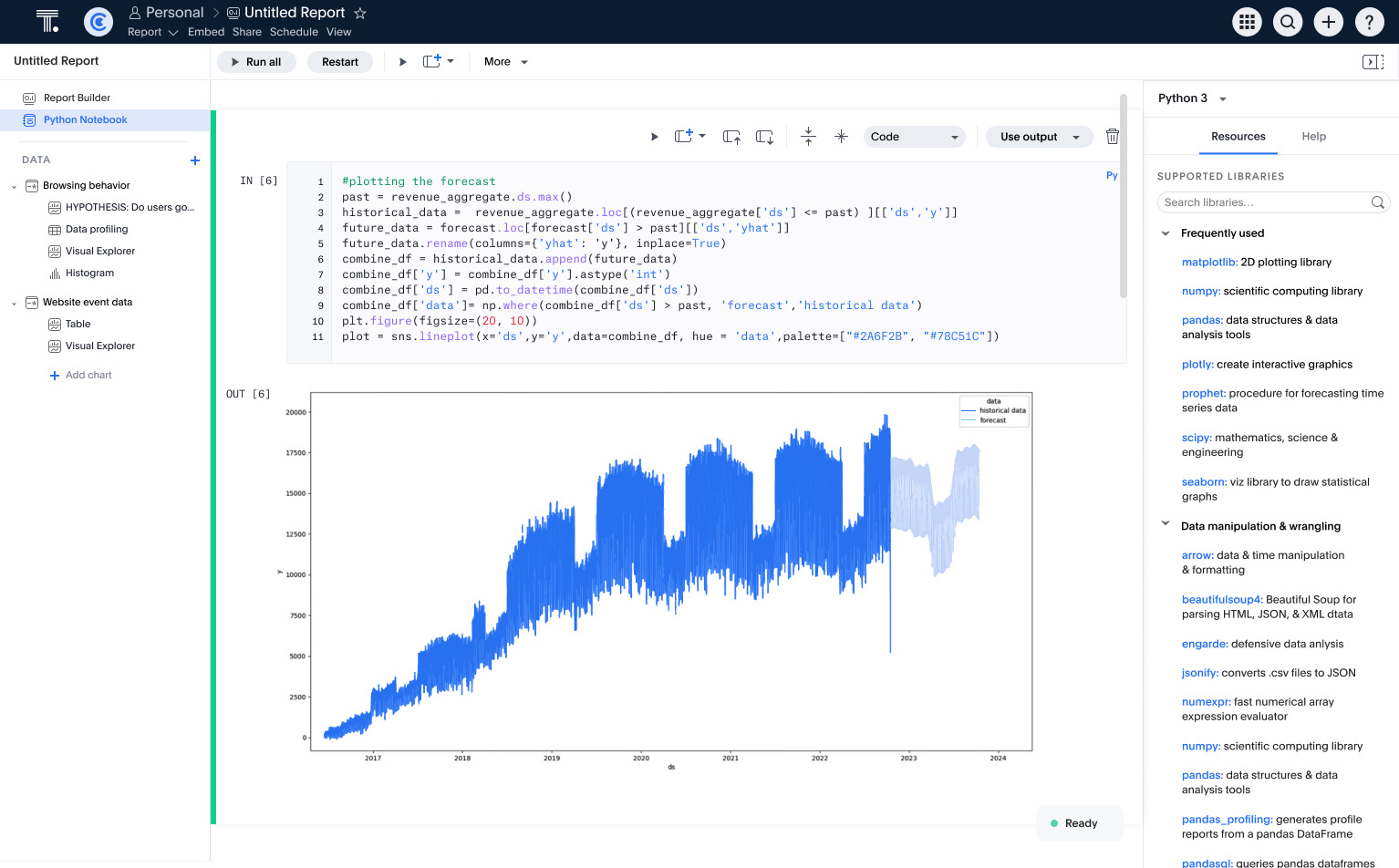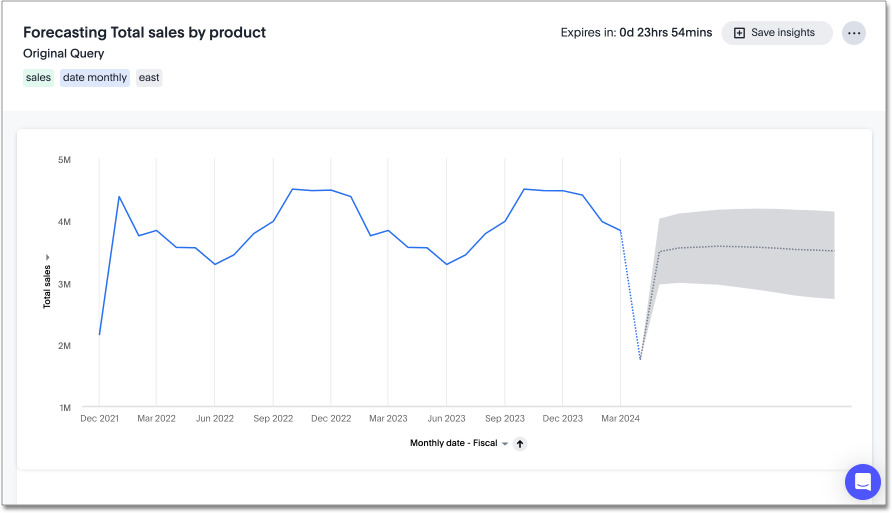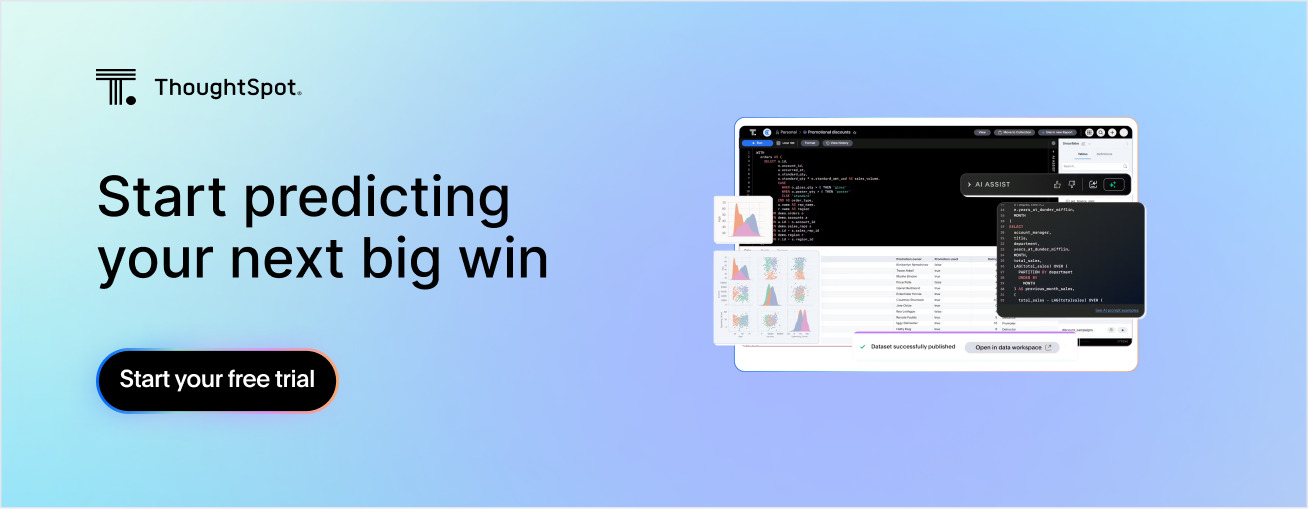If "predictive analytics" makes you picture hours of complex coding, then "predictive modeling" probably conjures an even deeper, more intimidating visual.
We get it. These terms often feel like they're reserved for a select few specialized people. The good news is: it's far more approachable than you think. At its core, predictive modeling helps answer the question you’re already asking: What happens next?
You're likely already looking at last quarter's numbers, spotting trends, and making educated guesses about the future. Predictive modeling just improves this process by adding data and AI into the mix.
So, how does it actually work? And more importantly, which tools and techniques are worth your time? This guide breaks it all down.
Table of contents:
Predictive modeling is the process of using historical data, statistical techniques, and machine learning algorithms to forecast what’s likely to happen next.
In simple terms:
You start with historical data, like website visits, customer purchases, or product returns.
You feed this data into a model, which is essentially a mathematical formula or AI algorithm. This model then meticulously studies your data, identifying patterns and learning the relationships between different inputs (like your ad spend) and specific outcomes (like conversion rates).
Once trained, the model can forecast future outcomes based on new or existing data. For example, it can answer questions like:
Will this customer buy again?
How much stock will we need next quarter?
Are we on track to hit our revenue goal?
This means you're not just reacting to events after they happen; you're proactively spotting trends and taking informed action much earlier.
And while modeling plays a key role, it’s just one part of the broader predictive analytics picture, one that spans everything from data prep to delivering actionable insights.
1. Forecasting demand
A sudden spike in demand can throw even the most well-oiled operation off balance. Overshoot, and you’re left with unsold inventory eating into margins. Undershoot, and you leave revenue on the table while competitors swoop in to fill the gap. Either way, you face a significant risk.
Predictive modeling gives you the insight to strike the right balance. This advanced analytics technique uses historical trends, marketing performance, regional behavior, and even competitor signals to forecast demand with precision—down to the channel, region, or customer segment.
The payoff? Leaner operations, sharper execution, and the confidence to scale without second-guessing.
2. Personalizing experiences
Why do some brands feel like they just get you, while others totally miss the mark? It’s not luck. It’s predictive modeling.
That streaming app that knows exactly when to suggest your next binge? Predictive.
The skincare brand that hits your inbox just as you're running low on your favorite products? Predictive.
Even the grocery app that reminds you to restock your Friday night snacks? You guessed it—predictive.
These moments come from AI models trained on patterns in your behavior, including what you buy, when you buy it, and how often you engage. Over time, the model gets smarter, learning things like when you're likely to run out of coffee or when you're ready to explore more advanced features in a product you use.
When these insights are delivered in the moment, personalization feels helpful, natural, and surprisingly human.
⚡ Discover how Hyatt is using AI and self-service analytics to predict guest behavior and tailor experiences in real time: Get the full story in this episode.
3. Reducing churn
Churn doesn’t show up all at once. It creeps in quietly. Maybe logins slow down. Engagement drops. Or, the renewal check-in never gets scheduled. Before you know it, that account is halfway gone.
Predictive modeling is your early warning system. These intelligent models meticulously study what churn has looked like in the past—what exact behaviors changed 30, 60, or 90 days before an account ultimately left.
Using that deep insight, the model flags similar patterns the moment they emerge. For instance, if a key customer disengages or usage dips sharply after a support issue, the model spots it and raises an immediate flag. That precise foresight empowers your team to step in and take action.
Powered by advanced predictive models, gives your team the power to detect risks and fundamentally change outcomes.
From forecasting sales to detecting fraud, predictive modeling uses a range of techniques tailored to your data and objectives. Here are a few important ones:
| Technique | What it does | Why it matters | Examples |
|---|---|---|---|
| Linear regression | Models the relationship between one or more variables. | Helps quantify the impact of each input on a measurable result. | Predict how changes in price affect sales. |
| Logistic regression | Estimates the probability of a binary outcome (yes/no). | Predicts the probability of an outcome happening and classifies it into a group. | Will this customer churn? Yes or no. |
| Decision trees | Splits data into branches based on feature values. | Provides clear, interpretable decision paths. | Classify loan applicants as low/high risk. |
| Random forest | Combines multiple decision trees to improve performance. | Improves accuracy and handles overfitting. | Predict default probability based on financial history. |
| ARIMA / Exponential Smoothing | Uses modeling to detect trends and seasonality in time-series data. | Delivers more reliable time-based forecasts. | Forecast weekly demand in retail. |
| K-means clustering | Groups similar data points based on shared characteristics. | Helps discover hidden segments in your data. | Segment users by buying patterns. |
| Neural networks | Detects complex patterns in large datasets. | Great for unstructured or high-dimensional data. | Product recommendations or fraud detection. |
The real power of predictive modeling comes from using the right mix of techniques.
Need to explain a decision? Go with interpretable models like regression. Want accuracy? That’s where neural networks help. The key is knowing when to use which, so you can drive action and build trust across the business.
Not all models are built the same.
Let’s break down the different types and when to use them.
| Type | What it does | Why it matters | Examples |
|---|---|---|---|
| Time series forecasting | Analyzes trends and seasonality over time. | Forecasts future values based on past behavior. | Anticipate weekly product demand. |
| Regression analysis | Identifies relationships between variables. | Predicts outcomes based on one or more influencing factors. | See how discounts, usage, or onboarding speed impact customer retention. |
| Classification models | Categorizes data points based on labeled inputs. | Predicts binary or multi-class outcomes. | Flag high-risk loan applicants. |
| Clustering | Groups similar data points without predefined labels. | Uncovers hidden patterns or segments in your data. | Group customers by shopping habits. |
| Neural networks | Detects complex, nonlinear relationships in large datasets. | Handles high-dimensional, unstructured, or real-time data. | Power recommendation engines. |
💡 Start simple, scale smart. Once the foundation’s there, you can layer on complexity to support more advanced use cases.
1. Ecommerce
Imagine gearing up for ‘Black Friday’, your biggest sale of the year. But you’ve got a thousand moving parts: inventory to manage, promotions to run, delivery timelines to hit. There’s no room for guesswork.
Sales forecasts might tell you what is likely to happen, like a surge in traffic. But what if you need more precision? What if you want to predict the exact hour your site traffic will peak, which SKUs will sell out by midday?
That’s where going deeper with predictive modeling makes a real difference.
For example, with ThoughtSpot Analyst Studio, you can build these advanced forecasts using Python or R. That way, you can go beyond broad trends and model the exact conditions that impact your business, down to the hour, the product, or the region.
It’s how modern retail teams turn data into decisions and stay one step ahead when the pressure’s highest.

2. SaaS
Let’s be honest: Predicting revenue in SaaS is notoriously tricky. One unexpected churn, and suddenly your forecast is way off.
By analyzing historical sales cycles, usage patterns, contract values, expansion trends, and even CRM activity logs, you can build models that forecast likelihood to close, churn probability, and expansion potential, down to the individual customer.
For example, you can create a time-series forecast in Analyst Studio to project renewal revenue based on seasonality, usage health, or support ticket trends.

3. Telecom
Peak usage periods can strain even the most robust networks—but predicting those spikes takes more than guesswork.
With predictive modeling techniques like time series forecasting, geospatial clustering, and anomaly detection, telecom leaders can forecast demand with precision—by region, hour, device type, or customer plan.
For instance, you can model when and where video streaming or mobile gaming traffic will surge, and proactively adjust infrastructure capacity or bandwidth allocation. It’s how you maintain the quality of service while scaling intelligently.
4. Media and communications
Creating content is part art and part science, and predictive modeling helps with that science.
Using data from past content performance, audience behavior, seasonal cycles, and real-time sentiment, predictive models surface which themes, formats, or genres are most likely to capture attention.
This guides everything from content commissioning to release schedules, so you can invest in what your audience actually wants next, not just what worked last quarter.
⚡ Wonder how Netflix keeps up with an audience that’s always changing? Data and AI are the secret sauce—take a look behind the scenes.
Analytics has evolved. It’s time you did too.
Staying competitive is tough. Customer expectations shift overnight. Markets move faster than ever. And slow decisions only give your competitors more room to win.
With ThoughtSpot’s Agentic Analytics Platform, you break free from silos and slow cycles.
Step into Analyst Studio, where you can build, test, and deploy Python or R-based predictive models directly on live data.
And that’s just the start. Whether you’re optimizing promotions, managing supply chains, or exploring hidden patterns, ThoughtSpot turns your data into foresight—and foresight into fast, confident action.
Get ahead of the curve. Try ThoughtSpot today.
Frequently asked questions
Is predictive modeling hard?
It doesn’t have to be. While building complex models can require data science expertise, many modern tools make predictive modeling more accessible to business users. The key is starting with the right data and clearly defining what you're trying to predict.
What are the disadvantages of predictive modeling?
Predictive models are only as good as the data behind them. Poor data quality, outdated inputs, or biased training data can lead to inaccurate predictions. There's also a risk of overfitting—when your model is too tightly tuned to historical data and struggles with new scenarios.
What’s the purpose of predictive modeling?
In simple terms: to make smarter decisions about the future. Predictive modeling helps you anticipate what’s likely to happen—so you can take action ahead of time rather than reacting after the fact.
Do predictive models always require machine learning?
Not necessarily. Some predictive models use traditional statistical methods (like linear regression). Machine learning in predictive analytics becomes more valuable when dealing with large, complex, or non-linear data.
How often should predictive models be updated or optimized?
It depends on how frequently your data changes. In fast-moving industries, regular updates are critical to maintain performance. Ideally, use predictive analytics tools that support continuous learning or automated refreshes to keep your models current and accurate.










